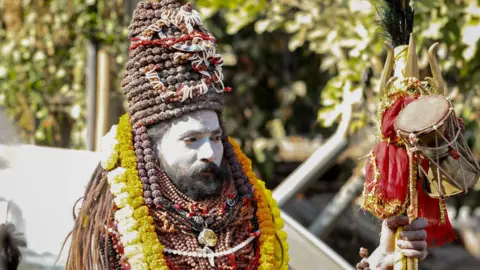 Ankit Srinivas
Ankit SrinivasNaked and ash-covered Hindu holy men rushed into the Ganges, India’s holiest river, at dawn on the most important first bathing day of the Kumbh Mela festival (also known as Mahakumbh ) in the town of Prayagraj, in the north of the country.
The ascetics chanted religious slogans, invoking Hindu gods and goddesses while diving into the icy waters.
After coming out of the water, some picked up a handful of silver sand and rubbed it on their bodies.
Many carried swords and tridents and one held aloft a silver staff with a serpent’s head.
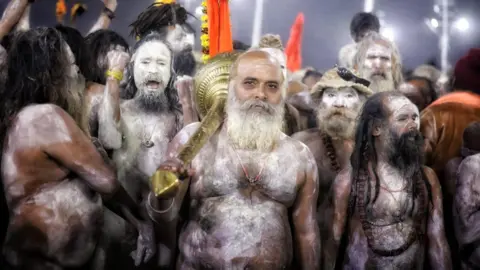 Ankit Srinivas
Ankit SrinivasAlongside these holy men – known as Naga sadhus – millions of Hindu pilgrims from around the world travel to Prayagraj to take part in a festival visible from space and billed as humanity’s greatest gathering.
Tuesday’s bathing spectacle takes place on the second day of the Kumbh Mela which takes place every 12 years. Authorities said that on the first day Monday, 16.5 million pilgrims bathed.
Hindus believe that this ritual will cleanse them of their sins, purify their souls and help them achieve salvation by freeing them from the cycle of births and deaths.
Police struggled to manage the growing crowd at the festival on Tuesday as thousands managed to enter an arena intended for ascetics.
Authorities say more than 400 million people are expected to take part in the 45-day spectacle, described as humanity’s largest gathering. It is so big that you can see it from space.
Tuesday’s bathing rituals, called Shahi Snan – or royal bath – will see ascetics arrive in batches at the Sangam – the confluence of India’s holiest Ganges with the Yamuna River and the mythical Saraswati – in colorful processions.
Their release attracts a lot of people from all over India and the world who come to seek their blessings.
Their presence also holds special significance for the great masses who believe that the waters of the river imbibe the purity of the thoughts and deeds of the saints when they bathe in the river.
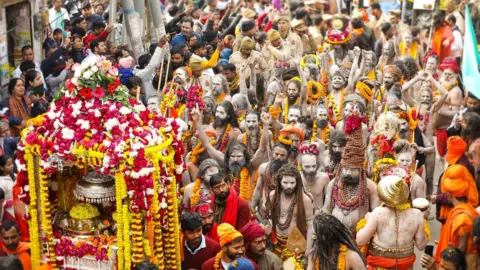 Ankit Srinivas
Ankit SrinivasWhat are the best swimming days?
There are six auspicious days for bathing this time, decided by astrologers, based on the alignment of specific planets and constellations. They are:
- January 13: Paush Purnima
- January 14: Makar Sankranti
- January 29: Mauni Amavasya
- February 3: Basant Panchami
- February 12: Magh Purnima
- February 26: Maha Shivaratri
Three of them – January 14 and 29 and February 3 – have been designated as Shahi Snan days when Naga sadhus bathe.
The largest gathering is expected on January 29, when 50 to 60 million worshipers are expected to take to the water.
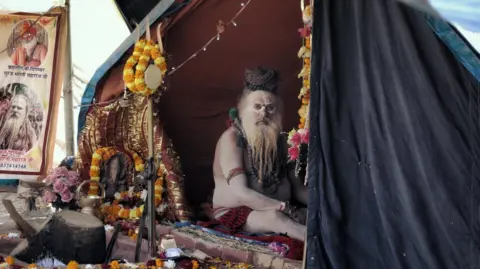 Ankit Srinivas
Ankit SrinivasAuthorities built a vast tent city on the banks of the river, spanning 4,000 hectares to accommodate holy men, pilgrims and tourists visiting the festival.
In recent days, we have seen groups of saints arriving at the mela grounds in large, noisy processions.
A group of holy men covered in ashes, some naked and others dressed simply in a loincloth or a marigold garland draped around their necks, paraded through the streets, holding tridents, swords and small drums with two heads.
Another group had its leaders on floats escorted to their encampment in a grand procession with musical bands, dancers, horses and camels.
The groups – known as akharas – have set up vast camps that are a hive of activity, with tens of thousands of pilgrims coming to hear religious talks or attend evening prayers.
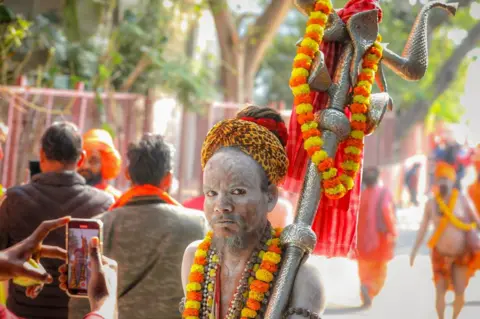 Ankit Srinivas
Ankit SrinivasThe origin of the festival is rooted in the mythological story of a fight between gods and demons over a Kumbh (a pitcher) of nectar that emerged during the worship of the ocean.
As both sides competed for the pot of elixir, a few drops overflowed and fell in four towns: Prayagraj, Haridwar, Ujjain and Nasik.
The Kumbh mela is organized in all four cities, but the biggest festivals are always held in Prayagraj.
Bathing dates and auspicious times are decided by astrologers, based on the alignment of specific planets and constellations.
Hindu seer Mahant Ravindra Puri says the current rare planetary alignments make this year’s festival “very special” and “a Maha (great) Kumbh”.
Mahant Puri will lead tens of thousands of holy men from his akhara to bathe on Tuesday morning.
“We believe that during the Kumbh Mela, the waters of the holy river will be infused with nectar,” he says.
“And those who have faith, Ganga maiyya (the river goddess) will bless them with whatever they want, whatever they need,” he adds.
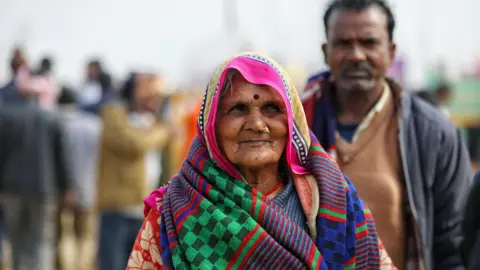 Ankit Srinivas
Ankit SrinivasApart from saints and ascetics, Tuesday’s bathing will also see millions of ordinary pilgrims heading towards the river.
On Monday, on the Mela grounds, we met Chitiya Ahirvar, who is visiting us from her village in the central Indian state of Madhya Pradesh.
The sixty-year-old who is traveling in a group of 20 people bathed in the river in the morning and will return on Tuesday.
“I prayed to the river goddess for the well-being and happiness of my children,” she said.
Mavaram Patel, a businessman from the southern state of Tamil Nadu, said he had heard a lot about the Kumbh Mela but had not had a chance to attend. get there earlier.
“Kumbh Mela is part of our ancient tradition. It is one of the most important festivals in Hinduism,” he told the BBC.
Mr Patel said he had prayed to the river goddess for the “happiness and well-being” of his “family and the world at large” and was also planning to bathe in the river on Tuesday morning before to leave the city.
“Visiting Prayagraj and bathing during Kumbh was on my list for a long time, so I am happy to be here,” he said.



